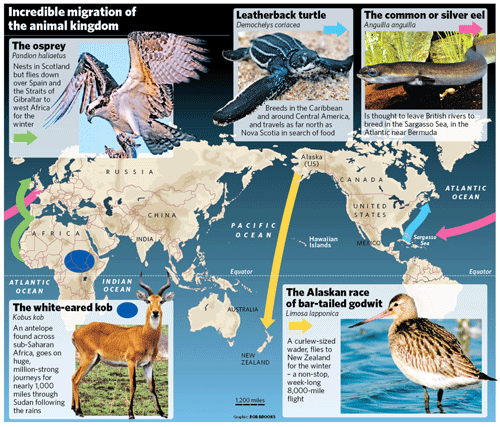Non-stop across the Pacific – one of many amazing journeys

We tend to think a seven-hour flight is tiring. Twelve is misery, and twenty-four, going to Australia, is just awful. But how about a transoceanic flight that lasts a week, non-stop?
A creature a fraction of our size can manage it, under its own steam. Every autumn, the bar-tailed godwit, a handsome, streamlined wading bird, flies 8,000 miles in a single hop across the Pacific, from Alaska to New Zealand.
Yet the godwit's astonishing migration, long suspected but proved conclusively for the first time by a bird fitted with a satellite transmitter, is only the most spectacular of many incredible journeys undertaken by wildlife around the world as part of their yearly routine to find food and warmth. And now these amazing migrations are to be spotlighted – and followed – by an ambitious new series on BBC Radio 4, entitled World On The Move.
The groundbreaking, 40-week series aims to take advantage of recent developments in tracking technology, not least the increasing miniaturisation of satellite transmitters, to follow birds, reptiles and mammals in their migrations, seeing where they get to, and how they get there.
Take the osprey, the striking, fish-eating hawk that returned to breed in Scotland in the 1950s after an absence of half a century. Ospreys migrate south to spend the winter in west Africa, and even as you read this, a female osprey, which nested last year in the Scottish Highlands, is fishing along the coastline of Guinea-Bissau. We know this because Roy Dennis, the Scottish naturalist and osprey expert, fitted her with a miniature satellite transmitter at her nest near Forres last summer, and has tracked her continuously since.
The solar-powered transmitter is designed to last for three years, so he hopes to follow her on her return in a few weeks, and World On The Move will track her with him. Listeners will be able to follow her progress home via Morocco, the Strait of Gibraltar, Spain and France, on the weekly half-hour programmes, or on the special website set up for the series.
Many other creatures will be tracked on their migrations, ranging from whales on both coastlines of the United States, and leather-back turtles migrating north from Florida to Canada or west towards the British Isles, to black-browed albatrosses which nest on Bird Island off South Georgia in the South Atlantic, and find their food on 2,000-mile foraging flights.
Three species of wild geese which winter in the British Isles will be followed on their strenuous journeys to their Arctic breeding grounds: barnacle geese, which fly north to Svalbard and white-fronted and brent geese which fly to Greenland and Canada.
Mammals to be followed include elephants, and the white-eared kob, an antelope that migrates in Sudan during the rainy season. Fish to be tracked include salmon, returning to the river Tyne to spawn, and eels from British rivers travelling to spawn in the western Atlantic. Even insects will be tracked: progress of the painted lady butterfly and the hummingbird hawk moth, migrants to Britain from southern Europe, will be reported on by listeners, with the help of the charity Butterfly Conservation.
Other wildlife charities acting as active partners in World On The Move include the Wildfowl and Wetlands Trust, the Royal Society for the Protection of Birds, the British Trust for Ornithology and the British Antarctic Survey. The programme-makers have also teamed up with universities, individual scientists, conservationists and specialist groups and linked with schools in countries ranging from Iceland to South Africa. "We want to follow global migration of all creatures, as it happens," said Brett Westwood, who with Philippa Forrester will present the series. "I don't think anything like this has ever been done before."
The Radio 4 series begins at 9am on Tuesday 12 February, continuing a week later in an 11am slot, repeated the following evening at 9pm. After a break in August it will return in September, just in time for the godwit migration.
Incredible journeys of the animal kingdom
* The Alaskan race of bar-tailed godwit, Limosa lapponica, a wading bird slightly smaller than a curlew, flies south to New Zealand for the winter. It is a non-stop 8,000-mile flight over the Pacific Ocean, lasting seven to eight days.
* The leatherback turtle, Demochelys coriacea, which breeds in the Caribbean and Central America, moves up the Atlantic as far north as Nova Scotia and even Ireland in search of jellyfish.
* The osprey, Pandion haliaetus, nests in Scotland but flies to west Africa for the winter. In spring it returns to the Highlands, north along the African coast and over the Strait of Gibraltar to Spain.
* The common or silver eel, Anguilla anguilla, leaves British rivers and is believed to breed in the Sargasso Sea, part of the Atlantic near Bermuda. Scientists from Britain's Centre for Environment, Fisheries and Aquaculture Science are to fit tracking devices to returning eels to see if their spawning grounds can be located.
* The white-eared kob, Kobus kob, an antelope found in sub-Saharan Africa, goes on million-strong journeys, for nearly 1,000 miles, in southern Sudan following the rains.
Subscribe to Independent Premium to bookmark this article
Want to bookmark your favourite articles and stories to read or reference later? Start your Independent Premium subscription today.

Join our commenting forum
Join thought-provoking conversations, follow other Independent readers and see their replies